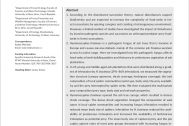Obsah
- According to the disturbance-succession theory, natural disturbances support biodiversity and are expected to increase the complexity of food-webs in forest ecosystems by opening canopies and creating a heterogeneous environment. However, a limited number of studies have investigated the impact of disturbance by invasive pathogenic species and succession on arthropod predator–prey food-webs in forest ecosystems.
- Hymenoscyphus fraxineus is a pathogenic fungus of ash trees that is invasive in Europe and causes massive dieback, mainly of the common ash Fraxinus excelsior across its native range. Here we investigated how this pathogenic fungus affects food-webs of web-building spiders and their prey in understorey vegetation of ash plantations.
- In 23 young and middle-aged ash plantations that were distributed along a gradient of infestation by H. fraxineus (29%–86% infestation), we measured the vegetation structure (canopy openness, shrub coverage, herb/grass coverage), the trait composition of local spider communities (web type, body size), the prey availability and the prey intercepted by spider webs. We then evaluated the multivariate prey composition (prey type, body size) and network properties.
- Hymenoscyphus fraxineus opened the ash tree canopy, which resulted in denser shrub coverage. The dense shrub vegetation changed the composition of web types in local spider communities and increasing fungus infestation resulted in reduced mean body size of spiders. Infestation by H. fraxineus reduced the availability of predaceous Coleoptera and increased the availability of herbivorous Coleoptera as potential prey. The mean body size of captured prey and the per capita capture rates of most prey groups decreased with increasing fungus infestation. Hymenoscyphus fraxineus infestation indirectly reduced the complexity in bipartite networks and the trophic functional complementarity in local web-building spider communities. The plantation age affected the vegetation structure but did not affect the studied food-webs.
- Forest disturbance by the invasive pathogen affected four trophic levels (plant–herbivore–coleopteran intermediate predator–top predator web-building spiders) and, contrary to the disturbance-succession theory, disturbance by the fungus simplified the web-building spider-prey food-webs. The results support the view that H. fraxineus represents a threat to the biodiversity and ecosystem functioning in the simplified ecosystems of ash plantations.



